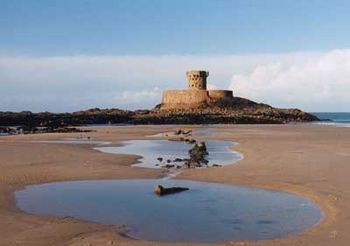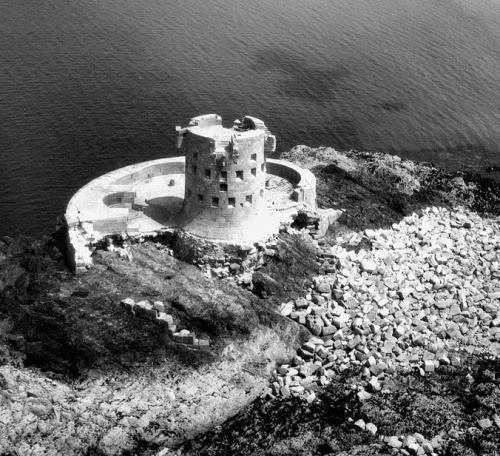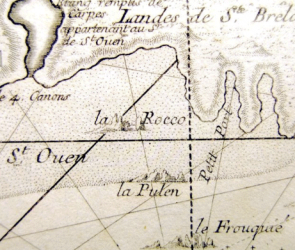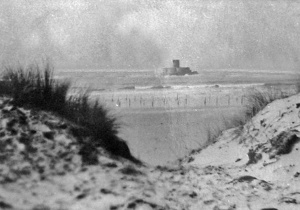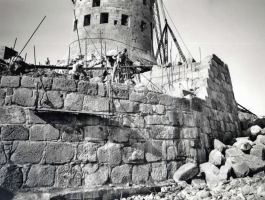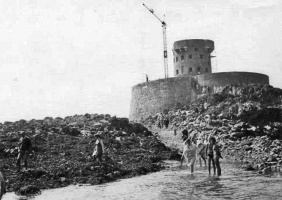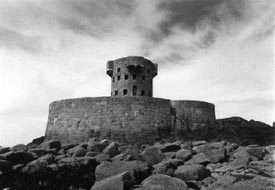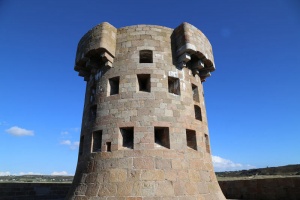La Rocco Tower is surrounded by the sea at half tide, but at low tide it can easily be reached from the shore.
It was severely damaged during or shortly after World War Two, but not through its use as a target for German gunnery practice, as is commonly believed. In the 1970s public demand, orchestrated by the then Rector of St John, the Rev Peter Manton, led to the States of Jersey deciding to repair and restore the tower.
The story of the tower
This history is based on an article by Paula Thelwell in the Jersey Evening Post in August 2019
La Rocco Tower was built between 1796 and 1801 to guard St Ouen's Bay from attack by the French at a time when France and Great Britain were sworn enemies.
It was one of 30 coastal towers proposed by Sir Henry Seymour Conway to be built around the coastline when he was appointed Governor of Jersey. His target was not met, because La Rocco was the 23rd and last built to Conway's design. It was the largest and most heavily armed of the series.
It was originally named Gordon's Tower, after the Lieut-Governor of the time, Lieut-General Andrew Gordon, but that found little favour with islanders.
The tower's military role declined in the second half of the 19th century and in 1923 the States bought the site from the Crown for £100, to provide a landmark for shipping, and under an obligation to maintain it in good condition.
Occupation damage
During the Occupation the Germans fortified St Ouen's Bay, which they believed was the most likely beach for an Allied landing. They adapted La Rocco Tower and laid landmines around it. The accidental detonation of some of these in 1943 caused significant damage, in particular a breach of the southern part of the gun platform, that allowed the sea to get in.
Legend also has it that the tower was further damaged by German soldiers at gun emplacements around the bay using it for target practice.[1]
In the 20 years after the Liberation constant pounding by rough seas left the structure on the verge of collapse. This would have suited the States, who had decided to let it fall into the sea. But the then Rector of St John, the Rev Peter Manton, was having nothing of that and devoted 12 years from the mid-1950s to saving the tower.
He was of the opinion that the terms of acquisition obliged the States to restore it.
Estimates of the costs were obtained and in April 1967 the Public Works Committee were told that it would cost between £50,000 and £90,000. There was no appetite among politicians to foot the bill from the public purse.
By then La Rocco was in a parlous state. Half of the terrace had been swept away and sea erosiion had reached the foundations of the tower itself. Simply to undertake essential repair work before a full restoration could begin would cost £35,000.
Ronez Quarries
Then Ronez Quarries stepped in, saying that they had new equipment that was capable of doing the work and their proposal would save money.
It would involve working on spring high tides to pump concrete through a pipe across the beach at a rate of 50 tons an hour. Once the sea had receded this would be supplemented by lorry loads of concrete being driven across the sand from Le Braye.
A crane and derrick would be installed to lift the original granite blocks that lay scattered, some up to 400 feet away and up to 12 feet under the sand, up to the tower's platform to be put back in place.
Ronez estimated that if the project began in April 1968, the concreting would take four weeks, with a further three months for stonemasons to undertake the essential granite work to again protect the structure from the pounding surf of St Ouen's Bay.
The States offered to pay half the cost if the remainder could be raised by public subscription, and an appeal committee was set up. It had representatives of the Rotary Club of Jersey, Lions Club of Jersey, the Association of Jersey Architects, La Société Jersiaise and the National Trust for Jersey, joined by Mr Manton. He said at the time:
- "This is our heritage and we want future generations to come to enjoy it unscarred, unblemished and unsullied, so that they can truly say that we were worthy of our stewardship."
The appeal was organised by the Evening Post and Channel Television . The Natonal Trust guaranteed £5,000 to set the ball rolling and by January 1968 the appeal had raised £14,000 and a huge community effort raised more so that work could start on schedule in April. Crowds of islanders lined the shore of the bay to watch Ronez battle against the elements.
Rebuilding the 35-foot high, 6-foot wide walls, repairing the forecourt and pouring concrete into the tower's base to reinforce the foundations were no light tasks. The foundations go down 20 feet and the largest blocks of granite winched up from the beach weighed as much as six tons.
Dinghy ride to work
For some workmen, getting to work meant a dinghy ride to the tower two hours before high tide to be ready for the concrete to be pumped from the shore. A six-man gang worked on the site, supported by another four when concrete pumping was in progress.
They began work at 6.30 am and regularly worked 13-hour days to make the most of the time the rising and falling tides - and occasional storms - permitted.
The initial emergency repair work was just the first phase of the project, which took three more years to complete.
Because of the tower's exposed location, staff from the Department of Public Building and Works could undertake the final repairs only from spring to early autumn.
In May 1971 a ceremony was held to mark the completion of the first phase to fully secure the tower's defensive wall against the sea. A plaque set into the wall marks this occasion.
The last phase of the restoration was undertaken between April and September the following year.
Wartime events
A history of wartime events from the Fortress Jersey Facebook group
Aircraft crash
On 1 November 1940 a Dornier Do 17P (Werknummer 4086) of 2(F),/Aufklarungs Gruppe 123 crashed just after take off from Jersey Airport. It appears that the aircraft suffered an engine failure causing it to bank left towards Corbiere and crashed on the rocks at the base of La Rocco Tower with three of the crew killed instantly and the fourth shortly after the crash.
They were:
- Leutnant Wilhelm Gohringer born 26 January 1916
- Feldwebel Kramer born 3 September 1915
- Uffz Karl Grunmuller born 12 August 1918
- Gefr Benno Pfiffner born 16 May 1917
Accidental damage
The tower seems to have been left alone until around the end of 1942, when it became a good ranging point for the various newly installed 10.5cm coastal defence guns from Corbiere to L’Etacq, with the tower still bearing impact marks today. Luckily only training shells with a low explosive yield were used.
There are also accounts of machine gun fire being brought to bear on the tower with apparently spectacular sparks and noise from the ricocheting rounds. When the German commander of the Channel Islands (von Schmettow) heard of this he issued an order that the tower was not to be used for target practice as it was an historic monument.
German soldier Horst Herrmann, who was stationed at Corbiere and the southern end of St Ouen’s Bay from September 1943, had the duty while serving at Wn Les Brayes to check a pole mounted detonation cable that connected the position to a redundant French 27cm shell that had been buried in the bulwark below La Rocco Tower. The purpose of this shell was to destroy the tower should it fall into Allied hands during an invasion.
The soldiers were required to check the tower if conditions had been favourable the night before for commandos to have landed. Herrmann was normally the first to climb the steps leading to the tower's bulwark and he was always worried that, if British commandos had landed on the tower the night before, one would be waiting at the top of the steps to put a knife in his throat.
During a live firing exercise at Strongpoint Corbiere, Herrmannt was being instructed in aiming a casemated 10.5cm coastal defence gun. He was seated at the gun operating the elevation and traverse wheels, while aiming at the chosen target rock in front of the tower as seen from La Corbiere. Having already experienced the shockwave and noise created by the gun being fired inside the bunker, het was ready to flinch at the point of firing.
The soldier firing the gun was just as nervous and his sweaty hands momentarily slipped on the firing lanyard while pulling, which resulted in Herrmann flinching too early. As he did so he altered the gun’s angle before it actually fired. He looked through the gun sight, not to see the target rock being hit, but what looked like “a puff of dust” rising from the top of the tower.
The shell had hit the southern machicolation at the top of the tower (which caused it to collapse post-war). Herrmann and the other soldiers with him kept this incident quiet as they were under strict orders not to hit the tower as it was viewed as an historic monument not to be fired at.
Herrmann was lucky that the shell being fired was only a training shell. Had a high explosive shell been used, a sizable chunk could have been taken out of the tower.
Halifax bomber
At some point in 1944 a Halifax bomber was returning from a patrol over the Bay of Biscay. The pilot was a headstrong and fearless Canadian who decided to pass over Jersey on the way back to base in England. While high over St Ouen’s Bay he spotted what looked to be the conning tower of a U-boat and decided to dive to attack.
As the Halifax dived Germans anti-aircraft guns at many positions in St Ouen’s Bay opened up and started strafing it. The Halifax crew got quite a shock. It is said the bombs were released before they realized that what they were attacking was in fact a tower in the bay and not a U boat, and the Halifax bomber was lucky to get away unscathed.
There is also an account of a German soldier firing his machine gun at an allied bomber from either Kempt or Lewis Tower with the four engined bomber so low that it was level with his position.
Mine damage
In the winter of 1944-45 several sea mines washed up on Jersey’s coastline and it is believed one hit and detonated against the southern bulwark of La Rocco Tower, causing damage to the masonry. By 1967 the constant pounding by rough seas had destroyed about half of the bulwark and the tower itself was on the verge of collapse. But thanks to the former Rector of St John, the Rev Peter Manton the tower was saved from destruction and the bulwark reinstated.
After the Liberation the 27cm shell placed under the bulwark was removed by the British Army. As these shells are notoriously unstable it was carried down a gully on the seaward side of the tower on a low spring tide and lowered in to the deepest accessible part of the gully. It was not rediscovered until 1995, still sitting in the gully, and was detonated in place by the local bomb disposal officer.
It has become local folklore that the tower was constantly shelled for target practice, causing the mostly post-war damage, which was the result of an Allied device damaging the tower's southern bulwark. If they wanted to, the Germans could have obliterated the tower in a morning. Once a 27cm shell was installed in 1943, the tower was not to be fired at as an impact could have caused the 27cm shell to detonate, taking the tower with it.
Conservation statement
In 2011 a conservation statement for the tower was commissioned by Jersey Heritage. It includes some of the photographs below
A visit by members of La Société Jersiaise while repair work was under way
Notes and references
- ↑ All of this is incorrect, but has been included for the purpose of formally dismissing these suggestions of how the damage was caused. The linked article from the 2009 Annual Bulletin of La Société Jersiaise, written by the highly respected historian Bob Le Sueur, who lived through the Occupation in Jersey, makes it clear that the tower suffered no significant damage before 1944. There was minor damage to one of the machiolations at the top of the tower when a German gun accidentally discharged when being aimed at a different target. The main damage is thought to have been caused by a floating mine drifting ashore. The Germans did not position mines all round the tower, but a single shell was buried under the flagstones of the bulwark at the base of the tower, which could have been activated from the 'resistance nest' at the top of Le Braye slip by means of a cable buried under the beach. If this shell had exploded accidentally, little evidence of a tower would have remained, as would also have been the case if German gunners had actually aimed their weapons at it
